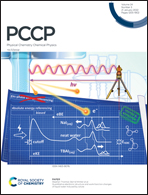Design of multifunctional spin logic gates based on manganese porphyrin molecules connected to graphene electrodes†
Abstract
The spin-resolved transport properties of molecular logic devices composed of two Mn porphyrin molecules connected to each other via a six-carbon atomic chain were studied using the non-equilibrium Green's function combined with density functional theory. The molecules were symmetrically connected to armchair graphene nanoribbon electrodes through four-carbon atomic chains on the left- and right-hand sides. Our calculations revealed that the spin-resolved current–voltage curves depend on the initial spin setting of the transition metal Mn atoms and carbon atoms on the zigzag edges where the electrodes come in contact with the molecule. By simultaneously regulating the spin orientations of the intermediate functional molecules and the zigzag edges of the armchair graphene nanoribbon electrodes, seven spin polarization configurations were obtained. These configurations were examined in this study considering the spin-related symmetry of molecular junctions. By meticulously selecting different combinations according to the specific input and output signals, YES, NOT, OR, NOR, and XOR multifarious spin logic devices were created. The findings of this study are expected to contribute toward the extension of molecular junction functions in future spintronic integrated circuit design and further miniaturization.



 Please wait while we load your content...
Please wait while we load your content...